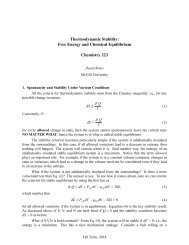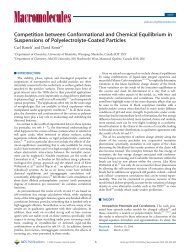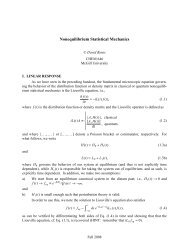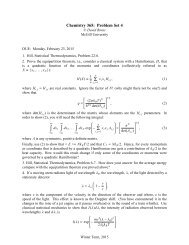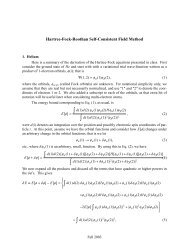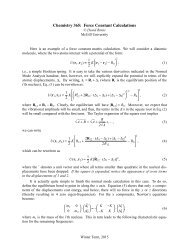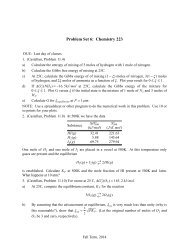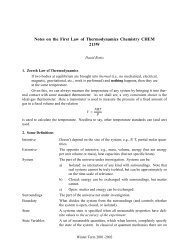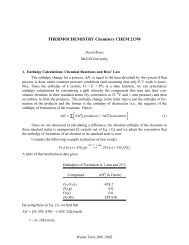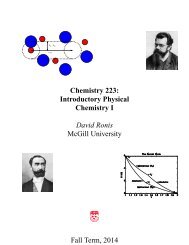Benoit Palmieri and David Ronis, Diffusion in ... - McGill University
Benoit Palmieri and David Ronis, Diffusion in ... - McGill University
Benoit Palmieri and David Ronis, Diffusion in ... - McGill University
Create successful ePaper yourself
Turn your PDF publications into a flip-book with our unique Google optimized e-Paper software.
<strong>Diffusion</strong> <strong>in</strong> Channeled Structures J. Phys. Chem. B, Vol. 109, No. 45, 2005 21339<br />
TABLE 2: Comparison with Experimental <strong>Diffusion</strong> Coefficients for the Two Potential Models, a <strong>and</strong> b<br />
our method TST<br />
a b a b ref 18 (R-quartz)<br />
∆Eq /kB(K) 7863 20 304 7912 20 601 6150 ( 750<br />
∆Sq /kB -11.80 -13.28 -12.52 -13.72 -32.47<br />
D′ 800 (m2 /s) 7.80 × 10-10 1.75 × 10-10 3.80 × 10-10 1.13 × 10-10 +8.8<br />
× 10-19 -log10 D800 13.38 20.78 13.72 21.13 21.43<br />
free energy takes the usual form, ∆A q ) ∆E q - T∆S q , where,<br />
as usual, ∆E q is obta<strong>in</strong>ed from the slope of a plot of ∆A q /T<br />
versus 1/T, compare to Figure 5. In Table 2, we report ∆E q ,<br />
∆S q , <strong>and</strong> D′ <strong>and</strong> compare them with the experimental values.<br />
We report both calculated <strong>and</strong> experimental D′ only at 800 K<br />
because the experiment never considered room temperature or<br />
lower.<br />
The Lennard-Jones parameters that we used are the same as<br />
those <strong>in</strong> I, but with modified target atoms radii (rO ) 0.9720 Å<br />
<strong>and</strong> rSi ) 0.6380 Å) such that our ∆E q agrees well with the<br />
experiment. This set of potential parameters, used everywhere<br />
unless specified otherwise, is denoted as “a” <strong>in</strong> Table 2. For<br />
this potential, the Arrhenius pre-exponential factor, that is,<br />
D′ 800 , differs by 8 orders of magnitude from that reported by<br />
Watson <strong>and</strong> Cherniak <strong>and</strong> the overall D at 800 K also differs<br />
by 8 orders of magnitude. Such a big difference very likely<br />
arises from a Boltzmann factor <strong>and</strong> strongly suggests that the<br />
current potential parameters (“a”) underestimate the strength<br />
of the actual guest-lattice <strong>in</strong>teractions <strong>and</strong> that the already large<br />
energy barriers of the system are, <strong>in</strong> fact, even larger.<br />
The limited free volume for argon to diffuse <strong>in</strong> R-quartz<br />
implies that argon is always <strong>in</strong> regions of strong repulsive<br />
potential of the closest crystal atoms. In this regime, small<br />
changes <strong>in</strong> the potentials’ parameters can drastically change the<br />
shape of potential surfaces. In fact, the depth of our Lennard-<br />
Jones potential was obta<strong>in</strong>ed <strong>in</strong> I from the London formula, 24<br />
<strong>and</strong> it is well-known that this approach tends to give smaller<br />
depths than others (like the Kirkwood-Muller 25,26 formula). In<br />
ref 27, it is shown that the London formula can give depths<br />
that are too small by a factor of 3. Moreover, these formulas<br />
model the attractive part of the potential. Here, it is the repulsive<br />
part that would need to be modeled accurately. As a test, we<br />
have redone the calculation with an <strong>in</strong>creased well depth (3 times<br />
larger), <strong>in</strong>creased oxygens radii (15% larger), <strong>and</strong> <strong>in</strong>creased force<br />
constants (20% larger). While the basic features of the energy<br />
l<strong>and</strong>scape are preserved with these parameters, albeit at higher<br />
energies, the local m<strong>in</strong>imum separat<strong>in</strong>g the b<strong>in</strong>d<strong>in</strong>g sites<br />
disappears. The results with this potential are denoted as “b” <strong>in</strong><br />
Table 2. The overall diffusion constant at 800 K agrees well<br />
with the experiment, but the ∆E q is now 3 times too large. For<br />
both sets of potential parameters, the factor D′ 800 is not well<br />
reproduced. This <strong>in</strong>dicates that both potentials fail to describe<br />
accurately the entropy loss as the lattice rearranges <strong>in</strong> the<br />
presence of the guest.<br />
In I, we noted that our potential model was only qualitative,<br />
but s<strong>in</strong>ce the typical energies were small, the accuracy was<br />
reasonable. Here, ma<strong>in</strong>ly because the energies are large, small<br />
changes <strong>in</strong> the potential parameters lead to large changes <strong>in</strong> D.<br />
An accurate potential model would be necessary for good<br />
agreement with the experiments. Of the limitations of our<br />
potential model are the facts that the repulsive part is poorly<br />
described, we have neglected all long-range <strong>in</strong>teractions, <strong>and</strong><br />
the lattice may start to show anharmonic effects consider<strong>in</strong>g<br />
the large displacements that are <strong>in</strong>duced by the guest. Note that<br />
there are certa<strong>in</strong>ly some sources of errors <strong>in</strong> the experiments<br />
com<strong>in</strong>g from surface effects, defects, impurities, <strong>and</strong> nanochan-<br />
8.2 -4.2<br />
nels, but Watson <strong>and</strong> Cherniak carefully checked that these were<br />
small <strong>and</strong>, <strong>in</strong> any event, cannot be used to expla<strong>in</strong> an O(10 7 )<br />
difference.<br />
VI. Discussion<br />
The effect of the crystal vibrations on the guest motion was<br />
also addressed <strong>in</strong> I, where we found that neglect<strong>in</strong>g the lattice<br />
vibrations <strong>in</strong>troduced only small errors for a system with small<br />
energy barriers. Here, we consider aga<strong>in</strong> the role of lattice<br />
vibrations. The effect of the crystal motion appears <strong>in</strong> several<br />
ways. First, at the level of the potential of mean force, allow<strong>in</strong>g<br />
the lattice to relax to a new equilibrium position <strong>in</strong> the presence<br />
of the guest (cf. eq 2.9) significantly reduces the energy barriers<br />
<strong>in</strong> W(z), for example, by 60kBT at 300 K <strong>and</strong> 18kBT at 800 K.<br />
As was mentioned before, this happens because the argon atom<br />
is always <strong>in</strong> the steep repulsive part of the closest lattice atoms<br />
before they are allowed to relax. Also note that the flexibility<br />
of the lattice is responsible for the temperature-dependent part<br />
of W(r).<br />
Second, aside from mean potentials, the question of the<br />
importance of the lattice vibrations on the guest dynamics can<br />
be addressed by compar<strong>in</strong>g the velocity autocorrelation functions<br />
for an argon atom released from a saddle po<strong>in</strong>t <strong>in</strong> our dynamic<br />
lattice <strong>and</strong> <strong>in</strong> an adiabatically equilibrated lattice. In the latter<br />
case, we mean that the lattice follows the guest adiabatically<br />
such that the net force on the lattice rema<strong>in</strong>s zero at all times.<br />
(0)<br />
This is achieved us<strong>in</strong>g an <strong>in</strong>itial RT that solves eq 2.9 <strong>and</strong><br />
(0)<br />
propagat<strong>in</strong>g RT <strong>in</strong> time accord<strong>in</strong>g to<br />
(0)<br />
dRT dt )-[ Keff + ∂2 (0)<br />
U(r,RT )<br />
(0)<br />
∂RT ∂RT<br />
(0) ]-1 ∂ 2 U(r,RT<br />
(0)<br />
∂RT ∂r<br />
In both simulations, the force felt by the guest is simply -∂U(r,<br />
(0)<br />
RT )/∂r [the temperature dependence of W(r) is ignored <strong>in</strong> the<br />
adiabatic lattice case <strong>and</strong> is implicit <strong>in</strong> the vibrat<strong>in</strong>g lattice case].<br />
The result is shown <strong>in</strong> Figure 7. The data shows that, for the<br />
(0) )<br />
dr<br />
dt<br />
(6.1)<br />
t<br />
Figure 7. Correlation function 〈V(t)V〉 <strong>and</strong> the <strong>in</strong>tegral ∫0 ds 〈V(s)V〉,<br />
shown for an argon atom start<strong>in</strong>g at a saddle po<strong>in</strong>t <strong>in</strong> an adiabatic,<br />
flexible, <strong>and</strong> frozen lattice simulation.




